It’s my favorite time of year: drafting season. Many of you are likely either prepping for your upcoming fantasy drafts or actively drafting right now, so I’m sure you’re all knee-deep in spreadsheets and Savant pages.
One of the most effective ways to prep for fantasy drafts is to look through underlying metrics for both hitters and pitchers and try to identify some draft targets based on ADP and expected performance. With all of the different routes you can take for player evaluation, however, it can become difficult to nail down an approach that makes you feel confident in your drafting.
Luckily, a new player evaluation model introduced here at Pitcher List has gone live recently. So, in the spirit of the season, I’m going to do a deep dive into the new PLV model, its evaluative prowess for pitchers, and some under-the-radar major league arms that the model loves at their respective ADPs.
Without further ado, let me introduce you to this exciting new tool and its implications for fantasy baseball.
The Power of PLV
So, how exactly can PLV help us in this endeavor?
Much like the vast assortment of stuff and location metrics available out there, PLV was developed with one overarching goal in mind: find the best way to evaluate the effectiveness of both pitchers and individual pitches on a fundamental level. Among many other factors, PLV takes into account pitch velocity, movement, location, count, and batter handedness to give each pitch thrown a run expectancy score. These individual pitch scores are then aggregated to give overall scores for pitchers and each pitch in their arsenal.
I like to think of it as a sort of pitcher process evaluation tool. It helps us identify which pitchers have the best pitches characteristically, and which pitchers deploy their arsenal most effectively. Using this tool in conjunction with more traditional results-based numbers, we can begin to identify some arms whose big-league results didn’t coincide with PLV’s evaluation of their raw pitching ability.
Before we get too deep into this methodology, we’ll need to lay some groundwork. Let’s first establish that a pitcher’s PLA score is actually useful as an indicator of skill and predicted performance.
To do this, I’ve pulled the top 100 starting pitchers for 2023 based on average ADP between NFBC and RT drafts and their respective PLA scores, along with some widely-used performance indicators in xFIP, SIERA, and K-BB%. Let’s see how closely PLA is tied to our two ERA estimators of choice first:

Pretty strong correlation here. PLA seems to agree that pitchers with good stuff and good command of that stuff will inherently fare better in metrics that value a high number of strikeouts and a low number of walks. That makes total intuitive sense. It becomes even more apparent when we compare PLA to K-BB%, a simple yet effective metric that has been held in high regard in fantasy circles for years.
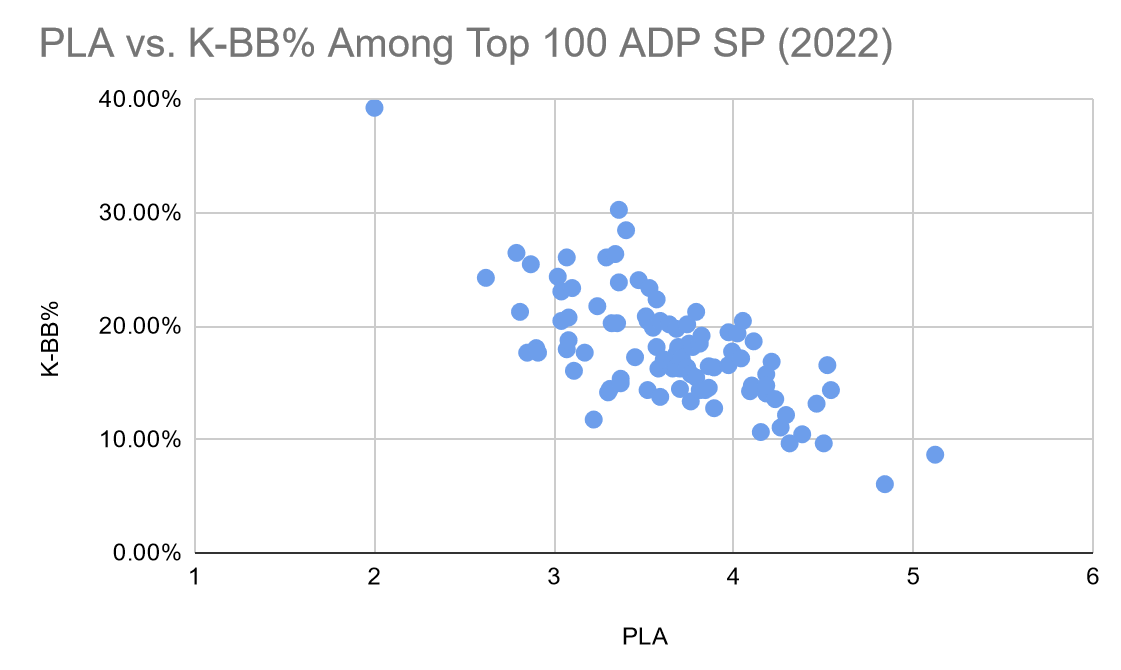
So, now we’ve established a baseline for our investigation. PLA is a solid all-encompassing tool to gauge pitcher performance. We could have also just looked at the top of the PLA leaderboard among starting pitchers for that as well. You’ll see some names that shouldn’t surprise you at the top.
On top of being a good performance evaluator, we also want to make sure PLA has some level of predictiveness to help us feel more confident about drawing conclusions on one-year data samples. Turns out, while not quite as predictive as some of the tools PLV uses to evaluate hitters, PLA is reasonably sticky year-to-year (thanks to Kyle Bland, @blandanalytics on Twitter, for pulling this figure):
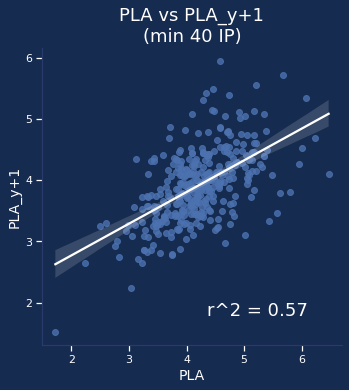
Great! Now we’ve established PLA as a nice, predictive figure that stabilizes relatively quickly and correlates well with some useful performance indicators. Now that that’s out of the way, we can start to pull some arms that aren’t getting enough fantasy draft love relative to their performance in the model.
I’ve separated this into starters and relievers to make the process a bit cleaner, and I’ve pulled 5 of each that jumped out at me during my investigation. Let’s go ahead and meet the starters!
Starter Sleepers
To make this a bit easier, I made a handy plot posing the top 100 starting pitchers by ADP against their PLA so we can easily pick out some outliers:
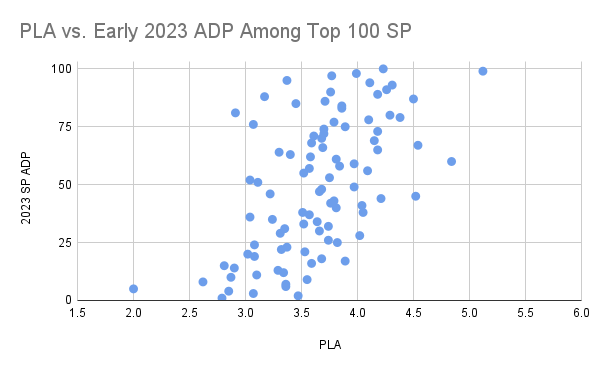
Ideally, we want to be choosing from the upper left-hand reaches of this chart: pitchers with a great PLA score, but a late ADP among starters. Instead, however, let’s start with a pitcher who isn’t even on this chart because he’s going outside the top 100 pretty consistently thus far.
Ryne Nelson, ARI
Let me give you something to chew on. Here’s the list of starting pitchers with at least 200 pitches thrown during the 2022 season and a better cumulative PLA score than Ryne Nelson:
Jacob deGrom, … That’s it.
Now 253 pitches over 18.1 innings is an extremely small sample (even for quick stabilizing metrics), so I wouldn’t expect that score to hold over a full season’s work. Still, Nelson flashed three pitches with elite PLA scores, and a healthy 52.2% of his pitches were considered quality by PLV. Not anybody can just do that.
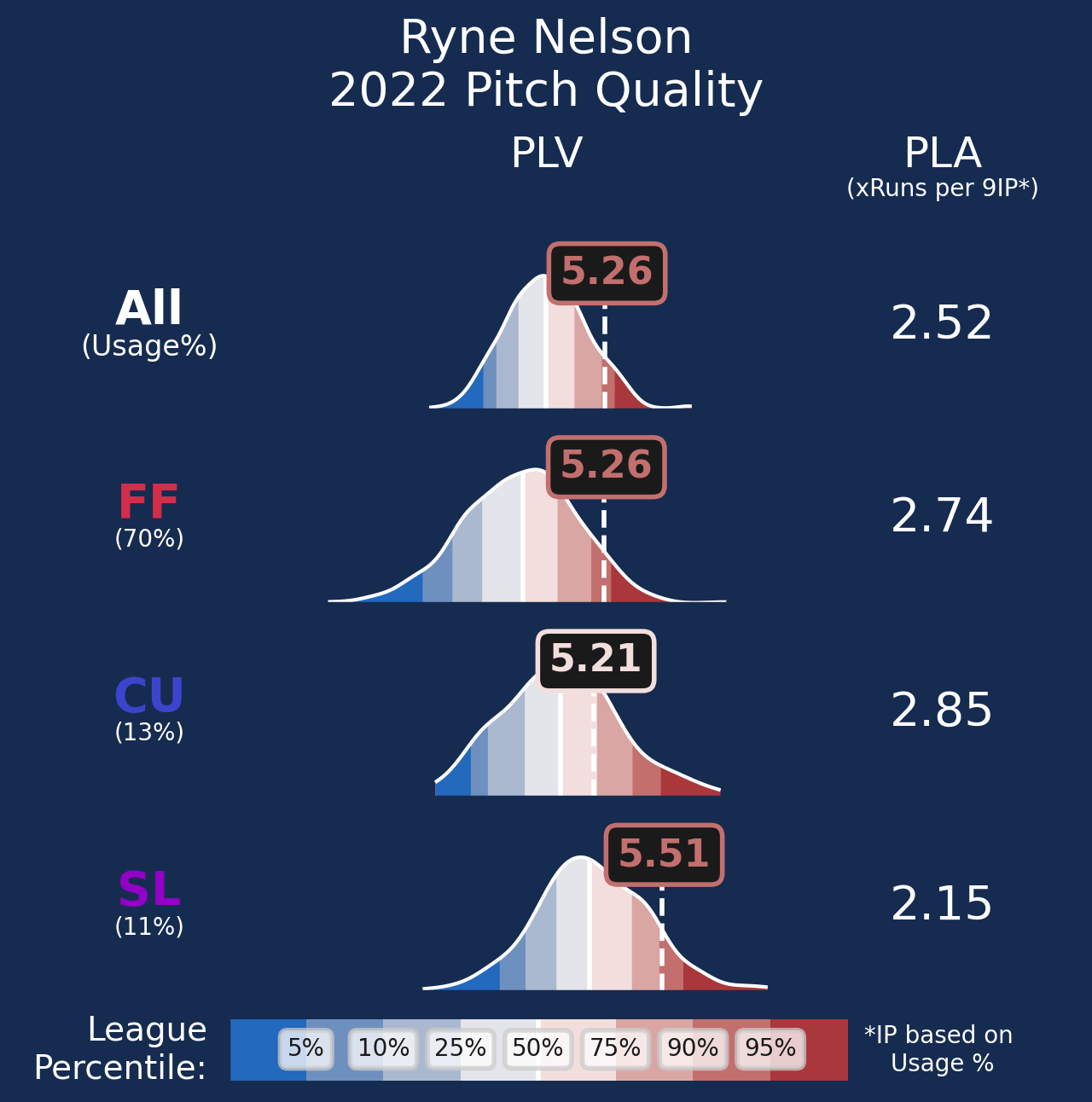
He passed the eye test with flying colors during his brief stint in Arizona, shutting down the potent Padres and Dodgers lineups for a combined 13.0 innings with 13 K’s, 2 walks, 6 hits, and 0 runs in his first 2 big league starts.
Putting the diamond into the @Dbacks, eighth-ranked prospect Ryne Nelson had a gem of a debut!
7 IP
0 R
4 H
0 BB
7 K pic.twitter.com/56e1cX7p9L— MLB Pipeline (@MLBPipeline) September 6, 2022
This begs the question: why isn’t Nelson being taken earlier in fantasy drafts heading into the 2023 season? Surely this profile is more alluring to owners than several back-end top 100 starters like Ian Anderson and Adam Wainwright.
Part of it may be due to the fact that Nelson’s 2022 season ended on the injured list with a scapula issue that hasn’t seen a definitive resolution. It may be because he’s a 25-year-old without the prospect pedigree of many other sought-after starters. It may even be due to his relatively limited arsenal and the tendency of his stuff to drop off past around 50 pitches per outing, signaling a high reliever risk.
All of that uncertainty seems to be scaring off owners from drafting Nelson early even though he will be competing for a rotation spot in Arizona this spring. Obviously, there’s significant risk here. You know what they say, though: Wherever there is danger, there lurks opportunity.
A lot of Nelson’s perceived value will come down to how he looks in Spring Training this year. If he comes into camp with a more diverse arsenal, refined command, and a clean injury slate, it’ll be hard to deny him a rotation spot. Many young pitchers with electric fastballs and one or two good breaking balls are incorporating cutters into their arsenals to bridge the gap between the movement profiles in their fastballs and sliders. A similar adjustment could work wonders for Nelson.
Regardless, he’s going to have to earn his way into the Arizona rotation out of the gate this year. If he does, though, this is absolutely the type of player who’s worth taking a flier on. For your own sake, keep tabs on him for the next few weeks, and maybe bump him up on your draft board accordingly.
Nathan Eovaldi, TEX
As another fun exercise in an entire article’s worth of fun exercises, I took those same top 100 starters by ADP I’ve been talking about and found out who had the biggest differences in their ADP rank and their PLV rank, both in the positive and negative direction. Here’s who PLV thinks are the best and worst value arms relative to ADP this year:
This, of course, doesn’t account for pitchers outside the top 100 ADP who ranked in the top 100 by PLV. We’ll get to a couple more of those guys momentarily. For now, let’s talk about Nathan Eovaldi.
Eovaldi signed a 2-year, $34MM deal with the Rangers in late December coming off a 2022 season that saw him limited to just 109.1 innings thanks to back and shoulder issues. This has pushed his 2023 ADP down into the 70s among starting pitchers, surrounded by guys like Jameson Taillon, Eric Lauer, and Cal Quantrill.
When he was on the mound last year, he was rock solid, although not quite as dominant as he was at times during his career 2021 season. He did see a decrease in his K/9 and his average fastball velocity was down about a tick, but PLV doesn’t think his stuff regressed all that much. In fact, his 2022 PLA was actually ever so slightly better than his 2021 score and was good enough for 18th-best among starters.
Eovaldi’s age may deter some owners, but there are reasons for optimism on that front as well. Generally, pitchers with a more diverse array of quality pitches at their disposal tend to age better than pitchers who rely primarily on two or three pitches. It’s what has allowed Yu Darvish and Charlie Morton to maintain their success well into their 30s.
Older pitchers have learned in recent years that relying on fastballs with declining velocity is not a sustainable approach as they enter the traditional age range for pitcher decline. The solution? Fewer fastballs, more secondaries.
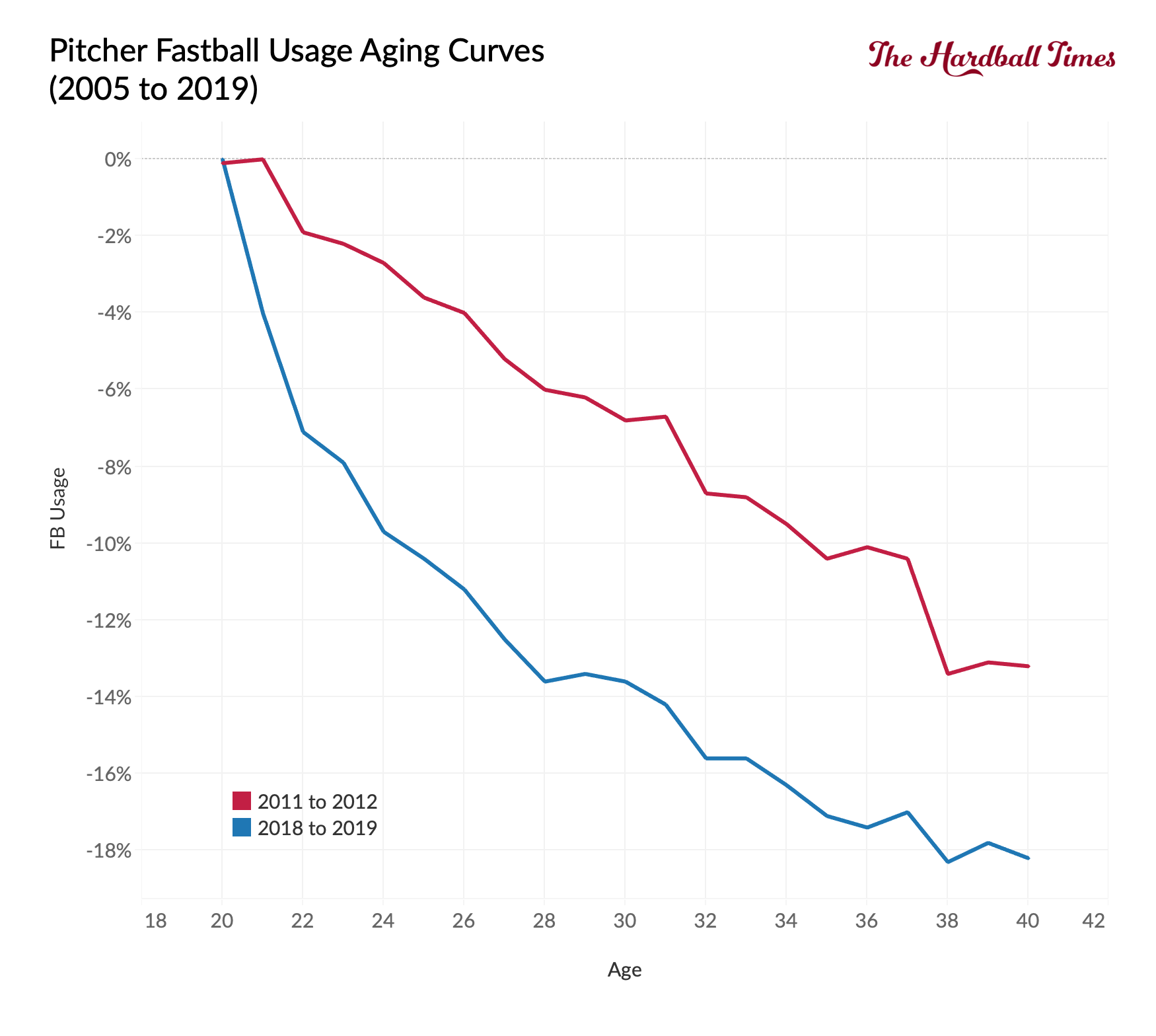
Leaning less on the fastball allows older pitchers to maneuver around declining stuff and sustain success deeper into their 30s, and it appears Eovaldi may be taking some small steps in that direction himself. His 48.4% fastball usage in 2022 was his lowest since 2015, and his breaking ball and offspeed usage have been trending upwards in recent seasons.
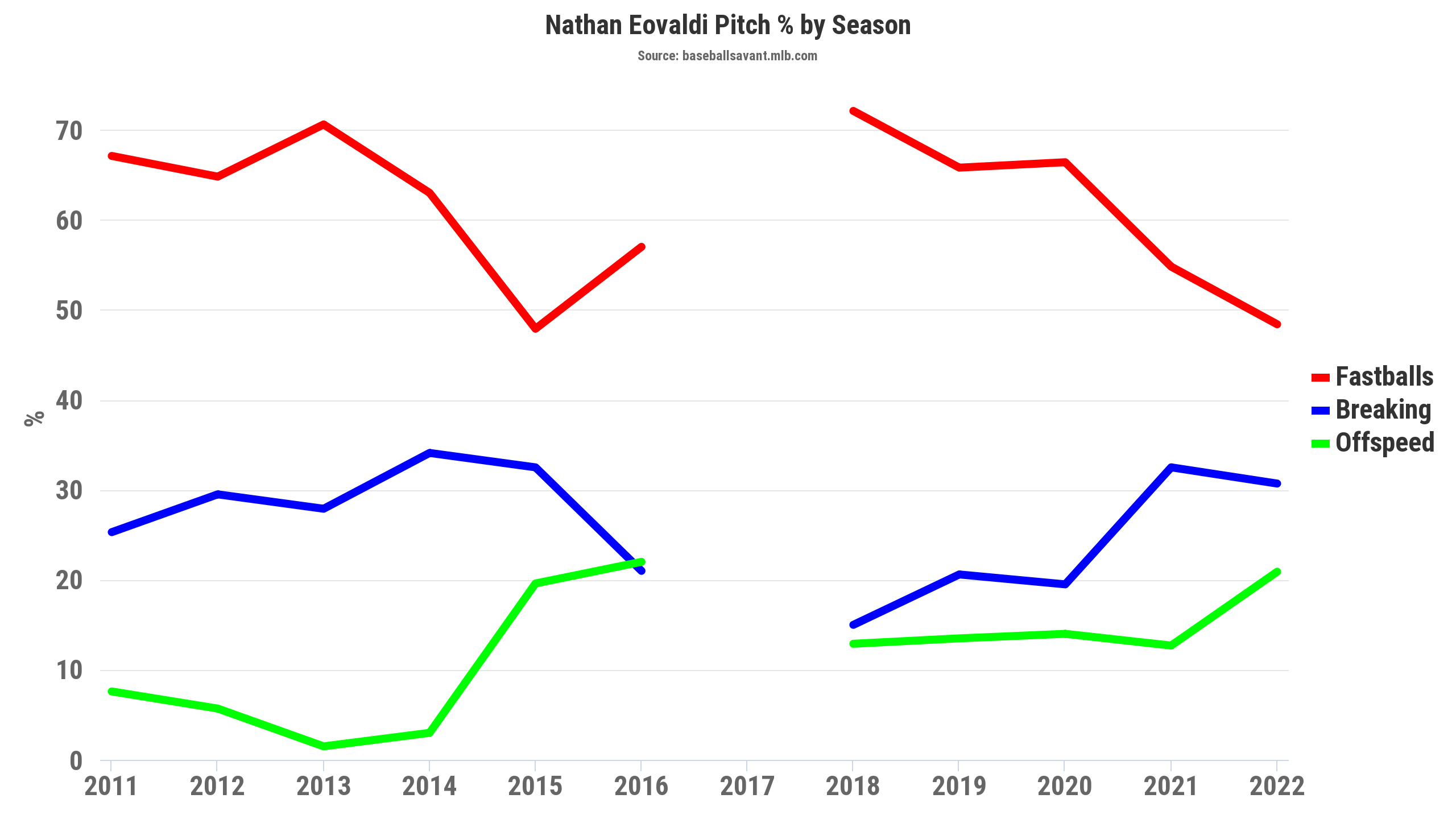
Eovaldi’s stuff isn’t going down the drain quite yet, mind you. His elite fastball, splitter, slider, and curveball PLA scores will attest to that. When the stuff does inevitably start to diminish, however, Eovaldi seems well-equipped to make the necessary adjustments.
Getting a reliable arm like Eovaldi who still has a veritable grab-bag of great pitches and is moving to a much better home environment later in drafts than a couple of guys who don’t even have a guaranteed rotation spot locked down on their team (sorry, Aaron Ashby. I’m still a big believer) just screams great value, and PLV agrees wholeheartedly.
Jeffrey Springs, TBR
Before I get to his fantasy value, can we talk about how crazy it is that we’re even talking about Jeffrey Springs as a top 100 fantasy starter at all? He was acquired by the Rays following the 2020 season as a 27-year-old reliever coming off a 7.08 ERA in 20.1 innings with Boston. After one solid year of relief with Tampa Bay in 2021, he was thrust into the rotation early in the 2022 season.
All he did from that point forward was put up a 2.66 ERA over 125 innings as a starter and sign a nice 4-year, $31M extension in the offseason. He was the final, 20th-round draft pick on one of my fantasy teams last year as a relief flier and ended up being the 2nd most valuable starter on that team. Completely insane.
And yet, after all that, he’s still not getting enough attention in fantasy drafts. You’ll notice he had the 4th highest positive discrepancy between ADP and PLV ranks in the chart I mentioned earlier. He’s going right around the 50th starter thus far behind guys like Tony Gonsolin and Lucas Giolito, whom that same chart ranks as some of the worst values around.
What exactly made Springs so good in 2022? Changeups, mostly. I mean, just look at these things.
https://gfycat.com/elasticflawlessharvestmen
This singular pitch defined Springs’ season. It ranked as the 4th-best changeup thrown by a starter by PLA, and one of the 20 best individual pitches thrown by a starter overall.
That’s not his only weapon, either. His fastball and slider were both above-average offerings as well. PLV saw Springs as a top-flight starter in 2022, with the 14th-best PLA score among starters and the 4th-best score among lefties. He fared better in the PLV model than Gerrit Cole, Carlos Rodón, Max Scherzer, Spencer Strider, and Cy Young winner Justin Verlander.

His low ADP relative to his 2022 performance has a few possible explanations. He has less than a single full season under his belt as a starter, so there may be some sample size and workload concerns. On the other hand, he has a pretty clean arm injury slate and not a ton of mileage on his arm for a 30-year-old. In fact, he’s never spent time on the major league IL with arm issues. His signing that extension with the Rays less than a month ago should further ease workload concerns in 2023.
As we established earlier, PLA is nice and sticky for pitchers year-to-year, especially ones who eclipsed 2,000 pitches in a given season. There still appears to be some lingering doubt about Springs’ ability to maintain his 2022 performance among fantasy managers. This gives you, genius fantasy manager that you are, the perfect opportunity to swoop in and take him at ADP.
If the Rays feel strongly enough about his ability to sign him through age 34, why shouldn’t we? They have more than earned the benefit of the doubt when it comes to pitchers at this point. This won’t be the last time you hear me say that in this piece, either.
Freddy Peralta, MIL
Alright, I’m going against my better judgment here. Applying the ADP – PLA rank methodology to Freddy Peralta does not paint him in a good light compared to the other starters discussed here, so just bear with me a bit.
Peralta is going around #42 among starters and #134 overall. That makes him the most costly arm I’ll be talking about in this piece, but I really think he has a chance to make his ADP look like a bargain by the time 2023 wraps up. He rates well in the PLA model with a score of 3.81. That’s safely above average and better than a few guys going well ahead of him in drafts like Lance Lynn, Robbie Ray, and Alek Manoah.
Peralta missed time in 2022 with lat and shoulder issues, finishing up with just 78 innings over 17 starts and one relief outing. He also missed time toward the end of the 2021 season, so he has some moderate injury risk attached to him. Given his age and contract status this upcoming season, however, the Brewers have every reason to let him fly in the rotation, so I wouldn’t worry too much about potential volume unless the injury bug bites again.
Peralta is equipped with a pretty deadly arsenal when his command is on (not a given), and he showed some encouraging signs late last year by adjusting his arsenal to play to his strengths better. He started to throw his curveball, his best pitch by PLA, much more in August and September, bringing his usage from just 7.6% in May to 28.8% in September.
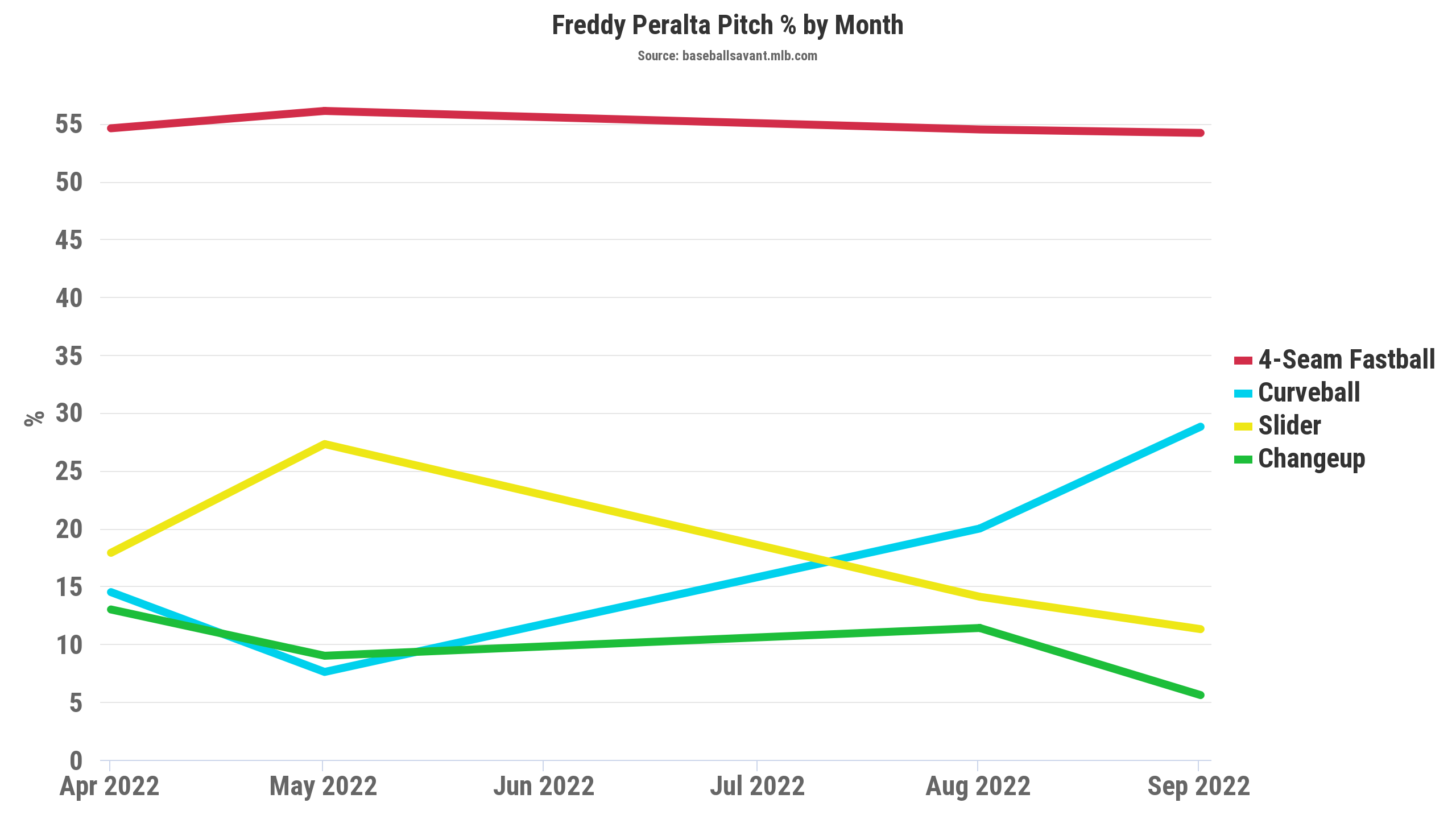
Throwing the curveball more gives Peralta the flexibility to attack hitters with his fastball more effectively than he already does. Speaking of, that fastball is an absolute anomaly. Much like the fastball thrown by Cristian Javier, Peralta’s four-seamer only sits around 92-93 mph but has eluded bats more effectively than most 95+ mph heaters thrown by other pitchers. His elite extension and high velocity-relative spin rate make it a supremely difficult pitch to square up, as detailed in this piece by Jeff Zimmerman published shortly after Peralta’s MLB debut.
He’s already been wildly successful in the big leagues by relying predominantly on his fastball. Incorporating more curveballs gives him a wider breadth of attack patterns, which is crucial for a guy with a single defining pitch like Peralta. Keeping guys off his already borderline unhittable four-seamer unlocks some downright unfair sequences like these:
https://gfycat.com/tautsnoopydoctorfish
To put it simply, a guy with a 31.3 K% and 75 FIP- over the last two seasons, one of the best fastballs in the game, and an arsenal that is rounding out nicely entering his age-27 season usually isn’t going to be available as late as Peralta will be this draft season. PLV doesn’t love him quite as much as some of the pitchers I’ve talked about here, but his age, contract status, team context, and arsenal adjustments all point to 2023 being a potential peak year.
In the ADP group consisting of Nick Lodolo, Lance Lynn, Joe Ryan, Chris Bassitt, Jesús Luzardo, and Peralta, Freddy is absolutely the one that stands out to me as being the best potential value.
Zach Eflin, TBR
Carlos Rodón, Spencer Strider, Max Scherzer, Framber Valdez, Zac Gallen, Brandon Woodruff, Corbin Burnes. What do all these pitchers have in common?
They all had lower PLA scores than Zach Eflin, the newest Tampa Bay Rays starter. Eflin’s 3.23 PLA ranked 25th among starters and included the 3rd-best sinker, 11th-best slider, and a top-25 curveball thrown by starters.
To be fair, Eflin wasn’t a starter for the entire duration of the 2022 season. He made 13 starts but was transitioned to the bullpen and made 7 relief appearances following his return from a right knee contusion he suffered in late June. Rest assured, the plan seems for him to be in the starting rotation in Tampa Bay. I doubt they would have paid a long reliever upwards of $11M a year for three years.
Over the course of his career, Eflin has been an unspectacular starter for the Phillies, never posting an ERA below 3.97 in any one season. Nothing on his career resume jumps out as spectacular, so what exactly prompted the Rays to drop $40M to lock him up? They wouldn’t just lay down the largest free-agent contract in club history for a guy they didn’t think they could squeeze immense value out of.
Well, one thing is certain: it has something to do with pitch mix optimization and bridging the gap between the movement profiles of the various pitches in his arsenal.
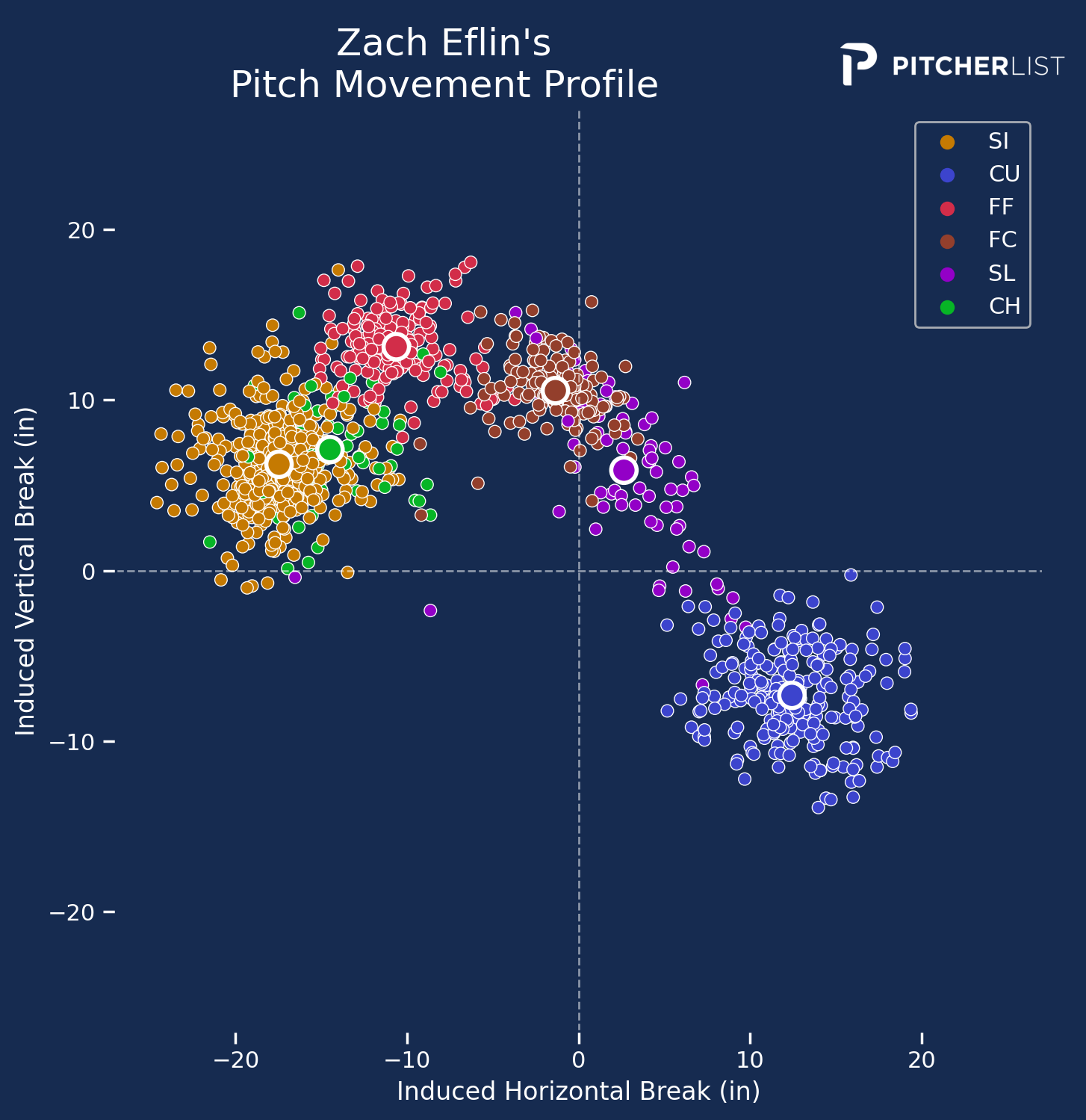
There is a lot going on here. Eflin’s diverse arsenal includes three fastballs with pretty distinct profiles, a sporadically-used changeup and slider, and a unique curveball with much more horizontal sweep than vertical drop. PLV likes all of these offerings to varying extents, but it loves the curveball and sinker in particular among Eflin’s most-used pitches.
If I were to hazard a guess as to what the Rays might be thinking looking at this arsenal, I would say they may see some underutilized tunneling potential here between the four-seamer/sinker, curveball, and cutter. Ditching the curveball/slider pair in favor of one singular sweeping breaking ball, straightening out and increasing the usage of his four-seamer, and bridging the gap between the two with the cutter is an approach that could immediately result in more whiffs and chases out of the zone for Eflin.
The key to all of this, however, is that Eflin has the ability to command every one of his pitches extremely well. That is what makes all of the pieces start to come together when considering why the Rays think so highly of him.
Normally, the Rays love taking guys with great stuff but poor command like Jason Adam and Pete Fairbanks, and simplifying their pitching plan with a single-target approach that gives them more confidence to attack the zone.
Eflin, on the other hand, already has the ability to pound the zone with all of his pitches. Most of the work is done for them. From here, all that’s left to do is develop a better pitch mix and let him do what he already does so well: execute.
Combine this with the Rays’ affinity for sinkers to same-handed batters chronicled in this piece by Cole Mitchem over at DRaysBay, and it becomes clear why they adore this profile. A guy who can command a diverse array of pitches, has inherently good stuff, and is maybe one or two adjustments away from drawing a ton of out-of-zone whiffs? That has Rays written all over it. Get in quick and reap the benefits before too many people catch on.
Reliever Sleepers
Now let’s take our search for undervalued arms to the bullpen. Admittedly, determining who is underrated from a fantasy standpoint for relievers is tough because so much of the value for relievers is tied to saves and holds. It’s great to have guys with great strikeout and walk rates, but it’s exceedingly hard to find a spot for them unless they’re getting at least a few save or hold opportunities here and there.
That complicates things for us, but not to worry! We’ll just have to go by feel more than hard numbers here when it comes to comparing ADP and PLA values.
Brusdar Graterol, LAD
The Dodgers are another team that seems to be consistently able to manufacture great pitchers at a low cost. The most recent and prominent example is Evan Phillips and his transformation into an elite back-end reliever during the 2022 season, but they’ve done this for years now.
When they acquired Brusdar Graterol from the Twins following the 2019 season, it was easy to get excited. A young sparkplug throwing 100-mph bowling ball sinkers and wicked sliders going to one of the 3 or 4 best pitching development organizations in the game? Sign me up.
Since then, however, the results have been relatively modest. In his time with LA, Graterol has pitched to a 3.64 ERA, 13.2 K-BB%, 3.36 FIP, and 27.5 CSW% over the last three seasons. Not bad by any means, but not quite to the level you’d think a guy with his natural ability could reach. The strikeout numbers especially are pretty pedestrian; he hasn’t even cracked a 20% strikeout rate in a single season thus far.
PLA loves him, though. He had the 5th-best aggregate PLA score among all relievers with at least 200 pitches thrown last year, the 8th-best slider, and the best sinker in baseball! Look at this arsenal; this is just ungodly stuff.
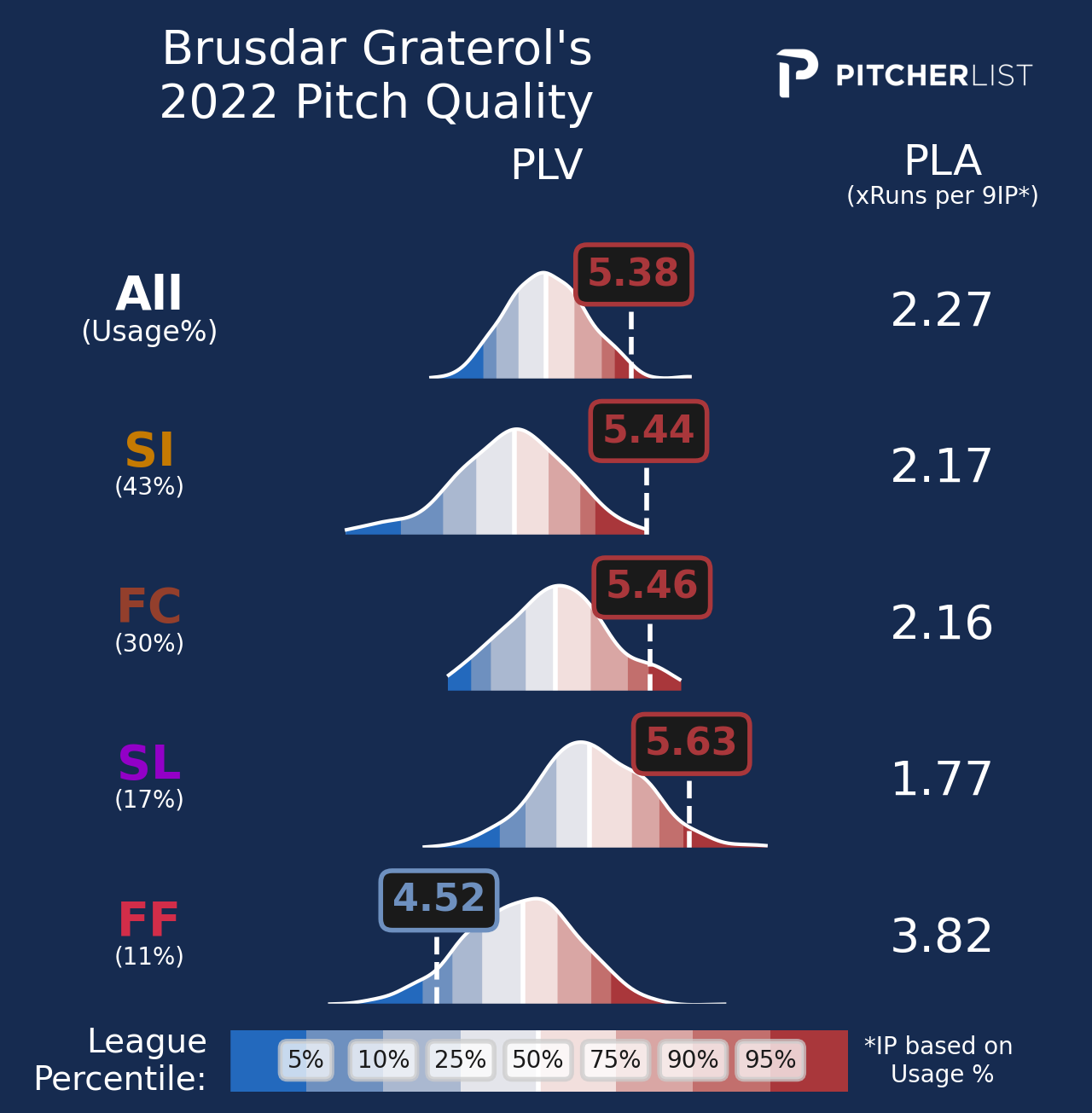
Aside from the four-seamer, every one of Graterol’s pitches ranks in the 90th percentile or greater, respective to their pitch type. He was also top-5 in quality pitch%, bested only by Jacob deGrom, Emmanuel Clase, Edwin Díaz, and Andrés Muñoz. By pure stuff and location, Graterol should be getting results comparable to the top-tier relievers in the game.
He’s still just 24 years old, so there is ample time for him to make the proper adjustments to draw more whiffs. He’s also pretty cheap right now, going around pick 61 among relievers and pick 414 overall. This is, again, largely because reliever value is heavily tied to saves and holds and the pitchers ahead of him have a track record of accumulating those opportunities. Still, guys without surefire closer jobs like Carlos Estévez and Gregory Soto are going well ahead of him.
As late as Graterol is going, you’re just throwing darts at guys who may eventually work their way into save opportunities down the line. Phillips, Daniel Hudson, and perhaps Blake Treinen all figure to get their fair share of save chances out of the Dodger bullpen, but they haven’t committed to a single closer since the departure of Kenley Jansen. A guy with Graterol’s arsenal, age, and opportunity is one of the best darts you could possibly throw this late in drafts.
Garrett Cleavinger, TBR
Much like Graterol, Garrett Cleavinger was a pitcher with modest results on the field but incredible scores in the PLV model. Cleavinger sported the 7th-highest PLA among relievers last year, with the 3rd-best left-handed sinker among all pitchers and a great four-seamer and slider. His stuff rated as 34% above league average, better than early-round closers like Ryan Helsley and Devin Williams.
An exceedingly unique aspect of Cleavinger’s game is that he’s noticeably better against righties than he is lefties. This is strange as a left-handed reliever, but it becomes more clear when you dig into what made him so hard to hit in his short Rays tenure in 2022. Essentially, Cleavinger hides the ball incredibly well and gives the hitter absolutely zero indication of what pitch is coming.
His mechanics prevent hitters from reading the ball until it has already left his hand. Strong tunneling paired with fundamentally good stuff allows Cleavinger to get some really ugly whiffs out of the zone, like this one to a fantastic right-handed hitter in Alejandro Kirk.
https://gfycat.com/aptadmirableboar
His ability to fool hitters with a lethal fastball-slider mix and his ability to pound the zone effectively with both pitches gives him the profile of a high-strikeout back-end reliever that should absolutely vie for some save and hold opportunities next season. Not the type of guy you are usually able to snag as the 167th pick among relievers.
Against righties in particular, Cleavinger’s approach consisted of an almost even split between four-seamers and sliders. Hitters were having to guess which pitch was coming without having any indication of which pitch it was based on spin or delivery. Lefties, meanwhile, were seeing an even split between sinkers and sliders, further reinforcing the idea that the Rays love to throw sinkers to same-sided batters. They were having to deal with stuff like this:
https://gfycat.com/lankyactualliger
We know the Rays love to mix and match when it comes to saves and holds, which gives Cleavinger more of an opportunity to accumulate value out of the bullpen than someone in his position on a different team might be able to. While Pete Fairbanks and Jason Adam appear to be the two highest-leverage arms out of the Tampa bullpen, it’s not hard to envision Cleavinger getting his fair share of high-leverage chances and forming a devastating late-innings trio.
Get your late shares of Garrett Cleavinger, folks. If you missed out on Jason Adam last year, here’s your shot at redemption.
Adrian Morejon, SDP
To be honest, I was tempted to group Adrian Morejon in with the starting pitchers in this piece. He was brought up through the Padres system as a starter and has made 8 big-league starts thus far in his young career. I still definitely see there being a future for him in the rotation, but for now, I’ll play it safe and assume he won’t be cracking San Diego’s deep rotation in 2023 barring any injuries. Even as a reliever, I’m excited about what Morejón is capable of.
He placed in the top-20 relievers in PLA during the 2022 season across his 34 innings and 540 pitches, flashing a great fastball and elite slider that rated as the 6th-best pitch of its type in the entire sport. He throws that fastball hard, averaging 96.9 MPH and just under 2500 rpm, both safely above the 90th percentile in the league.
He also features a changeup and curveball, but neither rated particularly well in the PLV model nor were they thrown too often last season. It was fastball first (69.1% usage), slider second (13.7% usage), and everything else only when necessary for Morejón as a reliever.
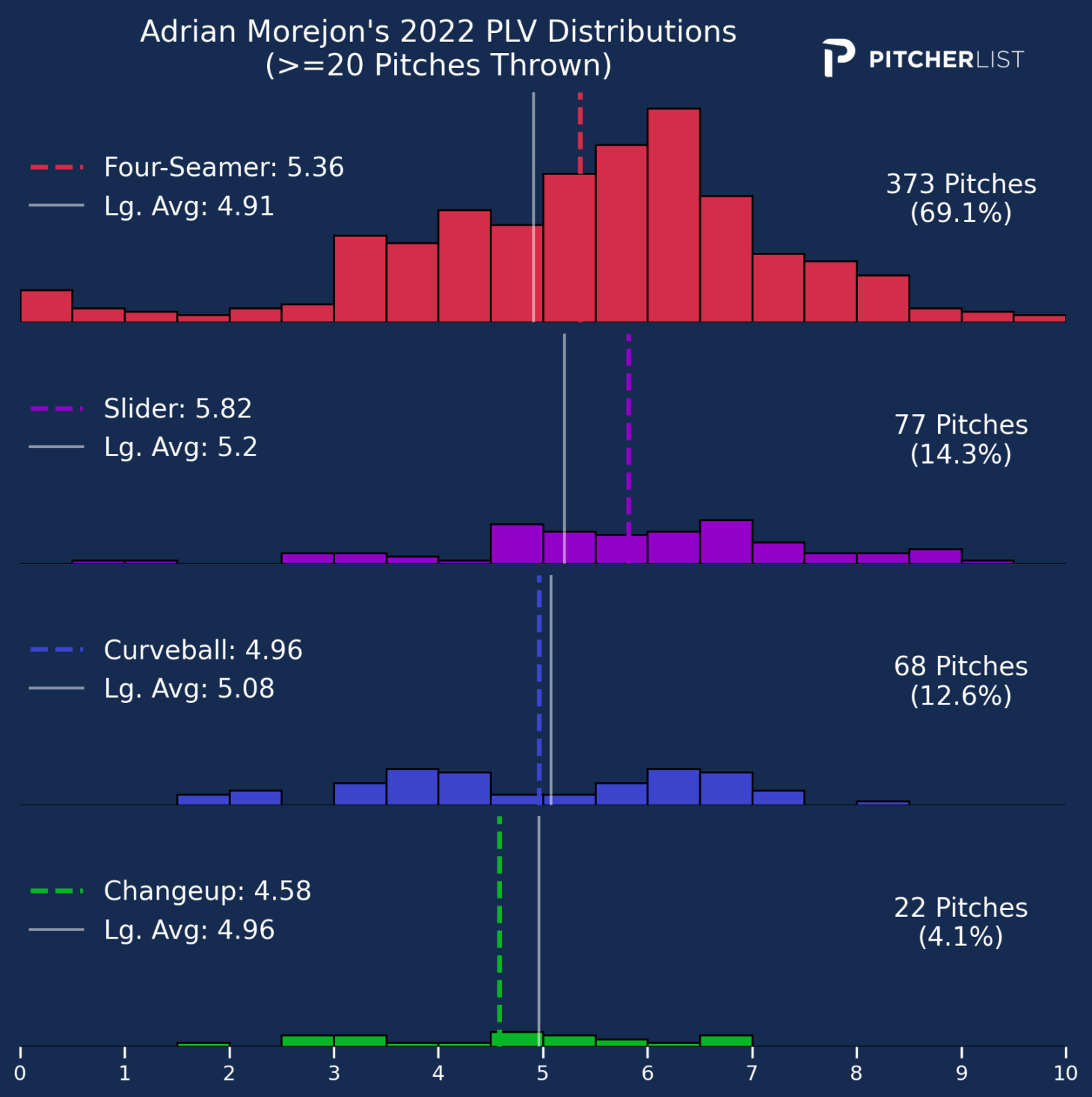
As a reliever, he can certainly work with that 2-pitch mix and still be effective. There’s room for optimization and adjustments, but he has a solid foundation to build on. The key here is that he’s still just 24 years old despite having pitched in parts of four big-league seasons thus far. He has more than enough time to find what works for him.
For now, though, there’s still good reason to seek him out in the late rounds of your drafts. Josh Hader and Robert Suarez are the two late-innings arms vying for save chances out of the Padres bullpen, but beyond those two, it’s a pretty long list of guys with limited big-league experience and varying degrees of upside. Morejón pops out as the one with perhaps the highest upside and even some potential to sneak his way into the starting rotation if everything breaks right for him.
He’s going as the 115th reliever overall in 2023. 24-year-olds with relatively extensive MLB exposure, a nonzero chance to start some games, and stuff like this don’t often come this cheap.
https://gfycat.com/composeddevotedcony
Keep a close eye on how the Padres deploy Morejón this spring to try and glean some information about his place on their big-league roster in 2023. If he’s throwing the ball well and getting some consistent innings against major league hitters, start considering grabbing some shares of him towards the end of your drafts.
The worst that can happen is he gets demoted to El Paso and you drop him guilt-free. Best case scenario, he could be the Jeffrey Springs of 2023 and cement himself as either a strong late-innings option out of the bullpen or even a young, intriguing starter to stash on your roster.
Yency Almonte, LAD
Let’s be honest: it’s borderline impossible for a reliever to maintain consistent success year-after-year while pitching in Colorado. That was the reality Yency Almonte was facing when he was DFA’d by the Rockies in October 2021 following a horrific 7.55 ERA that season. Everything he was throwing was getting crushed, nothing was going right, and his home ballpark was actively working against him.
Then, in a tale as old as time, a smart developmental organization (the Dodgers in this case) plucked Almonte out of the free agent scrap heap and got to work trying to figure out what went wrong and what could be salvaged from his previous approach. Through use of modern pitch design and strong coaching, Almonte reworked his arsenal and came into the 2022 season feeling as confident as ever.
All he did from there was put up a 1.02 ERA over 35.1 innings and work his way into some high-leverage situations out of the stacked Dodger bullpen by the end of the season.
What specific changes did Almonte make that turned his career around so quickly and completely?
For one, he became a sinker/slider guy instead of a four-seam/slider guy. While the effect of pitch mirroring isn’t exactly known or quantified quite yet, the general consensus throughout the league (at least among smarter teams) is that the sinker and slider work so well together because they mirror each other on the horizontal plane and create strong tunneling effects. It’s the same adjustment that turned Clay Holmes from a middling depth arm to a top-end reliever in 2022.
The problem was that Almonte’s slider had far more vertical break than it did horizontal, rendering that pitch mirroring effect mostly useless. So, naturally, the Dodgers got Almonte to add almost 4 entire inches of horizontal break and turn the pitch into a true sweeper. Just look at this:

That’s a completely different pitch altogether, and the results absolutely back up this change. Nearly every relevant result-based and stuff-based metric agrees that Almonte’s 2022 slider is in a completely different league compared to the 2021 version.
Almonte was an entirely different pitcher in LA, one who looked like a true late-innings threat that could hold his own in the highest-leverage situations baseball has to offer. Despite this, he’s still going dirt cheap in fantasy drafts. Pick number 178 among relievers makes him the cheapest arm I’ve talked about yet, and a prime opportunity to unearth some value late in drafts. To put this in perspective, Almonte had the 11th-best PLA among all relievers last year but is going later than Jake Diekman, who was 24% worse than league average by PLA and has an unclear path to saves at best in Chicago.
The new, refined Yency Almonte is still apparently being shadowed by the ghost of his former self in the eyes of many fantasy owners, but make no mistake. This is a pitcher with a devastating sinker/slider mix in one of the best organizations in baseball for performance maximization and a clear path to hold opportunities at the bare minimum.
Draft accordingly.
Reynaldo López, CHW
We can’t address the relief situation on the south side of Chicago without talking about Liam Hendriks and his ongoing battle with lymphoma. He’s a fantastic pitcher and human, and I wish him the absolute best with his treatment and a quick return to dominance in the near future.
That said, Hendriks’ absence from the Chicago bullpen for the time being opens up some opportunity for other guys to jump in and grab some saves. Kendall Graveman and Aaron Bummer figure to get long looks in the role, but the one I’m most interested in as of now is Reynaldo López.
Lopez quietly pitched to a 2.67 ERA and 0.95 WHIP in his first full season as a reliever, and there’s plenty of reason to believe the best might still be yet to come. He had the 21st-best PLA among relievers last season, with a standout four-seamer and slider. That’s a very appealing foundation for a reliever pitch mix, as I’ve mentioned earlier in this piece.
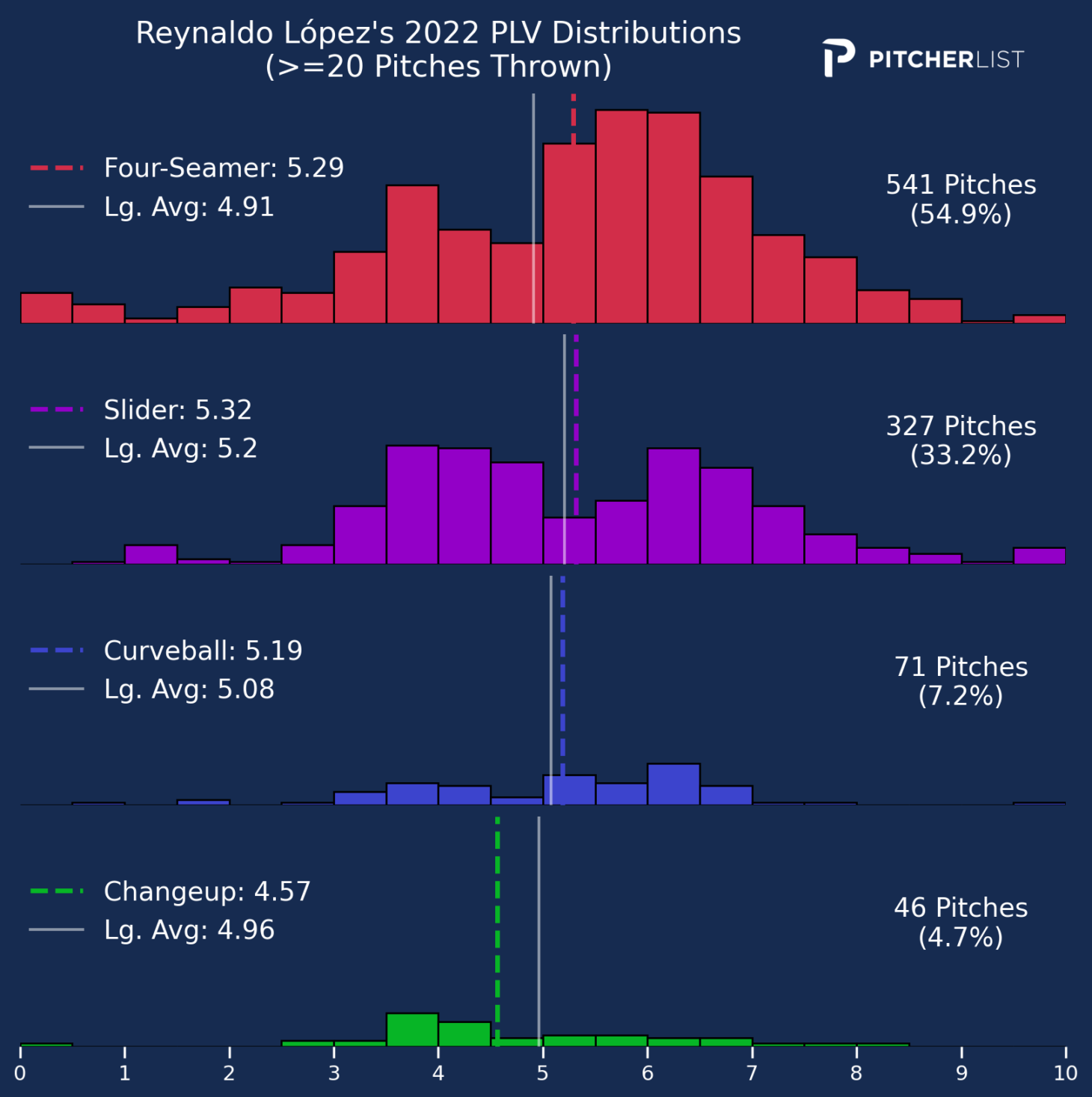
If Lopez is pitching well and the rest of the White Sox’s high leverage-relief corps begins to falter, he could very well work his way into the primary closer role. A big part of digging value out of relievers is identifying opportunity among guys with good stuff, and Lopez is as promising as any mid-to-late round bullpen arm out there in that regard.
He’s going at about pick #86 among relievers as of now, much later than a good handful of non-closers and even some guys who will miss a significant chunk of the season with injury, like Andrew Kittredge. The worst outcome here is you draft a boring multi-inning bulk reliever a little earlier than you should have, but the upside is abundant here.
Lopez has made some gradual adjustments over the course of his shift to the bullpen, and 2023 could be the year you finally reap all the benefits. If you’re looking for the reliever in this piece that is most likely to make an immediate impact at the back end of his team’s bullpen, this is your guy.
Wrapping Up
Whew. That was a lot to take in all at once.
We went through 10 pitchers and detailed why each and every one of them may have some untapped potential in the eyes of the PLV model as well as their respective standings in fantasy drafts. Only time will tell how successful this approach actually is, but the pitchers mentioned here all displayed some desirable skills on the mound but have remained out of the spotlight on the fantasy stage, to varying extents.
One thing is for certain: this is an entertaining and worthwhile exercise when prepping for fantasy drafts. How well owners scour the market for undervalued players is often the key determinant in who comes out on top in fantasy leagues, so analysis like this is a good habit to get into.
I strongly encourage everyone to sift through the PLV charts to pick out some outliers on their own, as well. Using the PLV pitcher and hitter evaluation tools can be a great starting point when compiling a list of targets in your drafts.
Feature image by Michael Packard (@CollectingPack on Twitter) / Photography by Sean M. Haffey/Getty Images & Matthew Pearce / Icon Sportswire


perhaps I’m blinded but I don’t see anywhere in this article where you define what the heck PLV and PLA actually is?
That would’ve been helpful.
Excellent article!!!